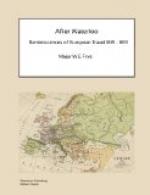This morning, after a promenade on the banks of the Meuse—for I am fond of rivers and woods (flumina amo silvasque inglorius)—we embarked on a treckschuyt and arrived here after a passage of four hours. The scenery on the banks of the Meuse all the way from Liege to Maastricht is highly diversified and extremely romantic; but here at Maastricht this ceases and the dull uniformity of the Dutch landscape begins. When on the ramparts of the city to the North and West an immense plain as far as the eye can reach presents itself to view; a few trees and sandhills form the only relief to the picture. The town itself is neat, clean and dull, like all Dutch towns. The fortifications are strong and well worth inspection. The most remarkable thing in the neighbourhood of Maastricht is the Montagne de St Pierre, which from having been much excavated for the purpose of procuring stone, forms a labyrinth of a most intricate nature. I advise every traveller to visit it, and if he has a classical imagination he may fancy himself in the labyrinth of Crete.
AIX-LA-CHAPELLE, 29th June.
We started in the morning of the 28th from Maastricht in the diligence for Aix-la-Chapelle and arrived here at twelve o’clock, putting up at Van Guelpen’s Hotel, Zum Pfaelzischen Hofe (a la Cour palatine), which I recommend as an excellent inn and the hosts as very good people. The price of our journey from Liege to Maastricht in the water-diligence was 2-1/2 franks, and from Maastricht to Aix-la-Chapelle by land was 7 franks the person. The road from Maastricht to this place is not very good, but the country at a short distance from Maastricht becomes picturesque, much diversified by hill and dale and well wooded. As the Meuse forms the boundary between the Belgic and Prussian territory, we enter the latter sooner after leaving Maastricht. I find my friend L. a most agreeable travelling companion; travelling seems to be his passion, as it is mine; and fortune has so far favoured me in this particular, that my professional duties and private affairs have led me to visit the four quarters of the globe. After dinner, on the first day of our arrival here, we went to visit the Hotel de Ville, before which stands on a pedestal in a bason an ancient bronze statue of Charlemagne. It has nothing to recommend it but its antiquity. The Hotel de Ville is similar to other Gothic buildings used for the same purpose. In the great hall thereof there is a large picture representing the ambassadors of all the powers who assisted at the signing of the treaty of Aix-la-Chapelle in 1742; and a full length portrait of the present King of Prussia, as master of the city, occupies the place where once stood that of Napoleon, its late lord. We next went to see the Cathedral and sat down on the throne on which the German Caesars used to be crowned. We viewed likewise the various costly articles of plate, the gifts of pious princes. The most remarkable things




